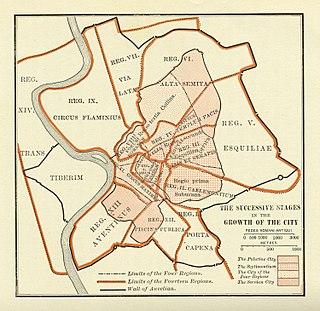
The Roman Kingdom, also referred to as the Roman monarchy, or the regal period of ancient Rome, was the earliest period of Roman history, when the city and its territory were ruled by kings.

Cloacina, "The Cleanser" was a goddess who presided over the Cloaca Maxima, the main trunk outlet of the system of sewers in Rome. The Cloaca Maxima was said to have been begun by Tarquinius Priscus, one of Rome's Etruscan kings, and finished by another, Tarquinius Superbus: Cloacina might have originally been an Etruscan deity. According to one of Rome's foundation myths, Titus Tatius, king of the Sabines, erected a statue to Cloacina at the place where Romans and Sabines met to confirm the end of their conflict, following the rape of the Sabine women. Tatius instituted lawful marriage between Sabines and Romans, uniting them as one people, ruled by himself and by Rome's founder, Romulus. The peace between Sabines and Romans was marked by a cleansing ritual using myrtle, at or very near an ancient Etruscan shrine to Cloacina, above a small stream that would later be enlarged as the main outlet for Rome's main sewer, the Cloaca Maxima. As myrtle was one of Venus' signs, and Venus was a goddess of union, peace and reconciliation, Cloacina was recognised as Venus Cloacina. She was also credited with the purification of sexual intercourse within marriage.

In Roman mythology, Hersilia was a figure in the foundation myth of Rome. She is credited with ending the war between Rome and the Sabines.
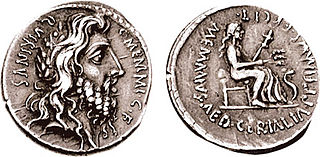
In Roman mythology and religion, Quirinus is an early god of the Roman state. In Augustan Rome, Quirinus was also an epithet of Janus, as Janus Quirinus.

The Sabines were an Italic people that lived in the central Apennine Mountains of the ancient Italian Peninsula, also inhabiting Latium north of the Anio before the founding of Rome.
Dionysius of Halicarnassus was a Greek historian and teacher of rhetoric, who flourished during the reign of Augustus Caesar. His literary style was atticistic – imitating Classical Attic Greek in its prime.
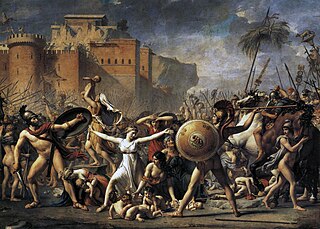
According to the Roman foundation myth, Titus Tatius was the king of the Sabines from Cures and joint-ruler of the Kingdom of Rome for several years.
The Consuales Ludi or Consualia was the name of two ancient Roman festivals in honor of Consus, a tutelary deity of the harvest and stored grain. Consuales Ludi harvest festivals were held on August 21, and again on December 15, in connection with grain storage. The shrine of Consus was underground, it was covered with earth all year and was only uncovered for this one day. Mars, the god of war, as a protector of the harvest, was also honored on this day, as were the Lares, the household gods that individual families held sacred.
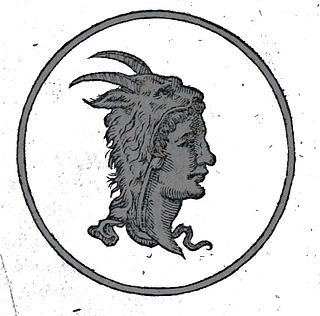
In ancient Roman religion, the Matronalia was a festival celebrating Juno Lucina, the goddess of childbirth, and of motherhood and women in general. In the original Roman calendar traditionally thought to have been established by Romulus, it was the first day of the year. As the first day of March (Martius), the month of Mars, it was also the Feriae Martis.

The Rape of the Sabine Women, also known as the Abduction of the Sabine Women or the Kidnapping of the Sabine Women, was an incident in Roman mythology in which the men of Rome committed a mass abduction of young women from the other cities in the region. It has been a frequent subject of painters and sculptors, particularly during the Renaissance and post-Renaissance eras.
Spurius Tarpeius is a mythological/historical character. He was the commander of the Roman citadel under King Romulus. His daughter, Tarpeia, betrayed the city to the fathers of the kidnapped Sabine women and asked for everything the Sabine warriors had on their left arms: it is thought Sabine warriors had gold bracelets and rings on their left arms. However, they crushed her with the shields they had on their left arms instead.

Romulus was the legendary founder and first king of Rome. Various traditions attribute the establishment of many of Rome's oldest legal, political, religious, and social institutions to Romulus and his contemporaries. Although many of these traditions incorporate elements of folklore, and it is not clear to what extent a historical figure underlies the mythical Romulus, the events and institutions ascribed to him were central to the myths surrounding Rome's origins and cultural traditions.
Raptio is a Latin term for the large-scale abduction of women, i.e. kidnapping for marriage, concubinage or sexual slavery. The equivalent German term is Frauenraub.
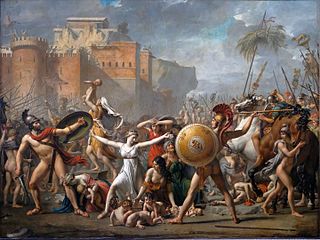
The Intervention of the Sabine Women is a 1799 painting by the French painter Jacques-Louis David, showing a legendary episode following the abduction of the Sabine women by the founding generation of Rome.
Caenina was a town nearby ancient Rome, in Latium.
Hostus Hostilius was a Roman warrior in the time of Romulus, and the grandfather of Tullus Hostilius, the third Roman king.
Titus is a Latin praenomen, or personal name, and was one of the most common names throughout Roman history. It was used by both patrician and plebeian families, and gave rise to the patronymic gens Titia. The feminine form is Tita or Titia. It was regularly abbreviated T.
El Rapto de las Sabinas is a 1962 historical drama film adaptation of the Roman foundation myth about the abduction of Sabine women by the Romans shortly after the foundation of the city of Rome.

In Roman mythology, the Battle of the Lacus Curtius was the final battle in the war between the Roman Kingdom and the Sabines following Rome's mass abduction of Sabine women to take as brides. It took place during the reign of Romulus, near the Lacus Curtius, future site of the Roman Forum.











